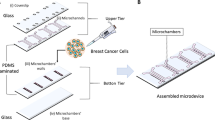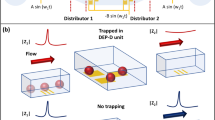Abstract
Multidrug resistance (MDR) is one of the major obstacles in drug delivery, and it is usually responsible for unsuccessful cancer treatment. MDR may be overcome by using MDR inhibitors. Among different classes of these inhibitors that block drug efflux mediated by permeability-glycoprotein (P-gp), less toxic amphiphilic diblock copolymers composed of methoxypolyethyleneglycol-block-polycaprolactone (MePEG-b-PCL) have been studied extensively. The purpose of this work is to evaluate how these copolymer molecules can reduce the efflux, thereby enhancing the accumulation of P-gp substrates (e.g., daunorubicin or DNR) in MDR cells. Using conventional methods, it was found that the low-molecular-weight diblock copolymer, MePEG17-b-PCL5 (PCL5), enhanced drug accumulation in MDCKII-MDR1 cells, but the high-molecular-weight version, MePEG114-b-PCL200 (PCL200), did not. However, when PCL200 was mixed with PCL5 (and DNR) in order to encapsulate them to facilitate drug delivery, there was no drug enhancement effect attributable to PCL5, and the reason for this negative result was unclear. Since drug accumulation measured on different cell batches originated from single cells, we employed the same-single-cell analysis in the accumulation mode (SASCA-A) to find out the reason. A microfluidic biochip was used to select single MDR cells, and the accumulation of DNR was fluorescently measured in real time on these cells in the absence and presence of PCL5. The SASCA-A method allowed us to obtain drug accumulation information faster in comparison to conventional assays. The SASCA-A results, and subsequent curve-fitting analysis of the data, have confirmed that when PCL5 was encapsulated in PCL200 nanoparticles as soon as they were synthesized, the ability of PCL5 to enhance DNR accumulation was retained, thus suggesting PCL200 as a promising delivery system for encapsulating P-gp inhibitors, such as PCL5.

ᅟ








Similar content being viewed by others
Abbreviations
- CsA:
-
Cyclosporine A
- DMEM:
-
Dulbecco’s modified Eagle's medium
- DMSO:
-
Dimethyl sulfoxide
- DNR:
-
Daunorubicin
- DOX:
-
Doxurubicin
- FBS:
-
Fetal bovine serum
- HBSS:
-
Hanks’ balanced salt solution
- MDCK:
-
Madin-Darby canine kidney
- MDR:
-
Multidrug resistance
- MePEG-b-PCL:
-
Methoxypolyethyleneglycol-block-polycaprolactone
- MTS:
-
3-(4,5-Dimethylthiazol-2-yl)-5-(3-carboxymethoxyphenyl)-2-(4-sulfophenyl)-2H-tetrazolium
- SASCA-A:
-
Same single cell analysis in the drug accumulation mode
- PBS:
-
Phosphate buffered saline
- PCL5:
-
MePEG17-b-PCL5
- PCL200:
-
MePEG114-b-PCL200
- PEN/STR:
-
Penicillin/streptomycin
- P-gp:
-
Permeability-glycoprotein
- SD:
-
Standard deviation
- Tryp/EDTA:
-
Trypsin-ethylenediaminetetraacetic acid
References
Thomas H, Coley HM (2003) Overcoming multidrug resistance in cancer: an update on the clinical strategy of inhibiting p-glycoprotein. Cancer Control 10(2):159–165
Chan LMS, Lowes S, Hirst BH (2004) The ABCs of drug transport in intestine and liver: efflux proteins limiting drug absorption and bioavailability. Eur J Pharm Sci 21:25–51
Marquez B, Van Bambek F (2011) ABC multidrug transporters: target for modulation of drug pharmacokinetics and drug–drug interactions. Curr Drug Targets 12:600–620
Sharom FJ (2008) ABC multidrug transporters: structure, function, and role in chemoresistance. Pharmacogenomics 9(1):105–127
Ayesh S, Shao YM, Stein WD (1996) Cooperative, competitive, and noncompetitive interactions between modulators of P-glycoprotein. Biochim Biophys Acta 1316(1):8–18
Shaffer BC, Gillet JP, Patel C, Baerc MR, Batesa SE, Gottesman MM (2012) Drug resistance: still a daunting challenge to the successful treatment of AML. Drug Resist Updat 15:62–69
Seeling A, Gerebtzoff G (2006) Enhancement of drug absorption by noncharged detergents through membrane and P-glycoprotein binding. Expert Opin Drug Metab Toxicol 2(5):733–752
Zhang W, Shi Y, Chen Y, Ye J, Sha X, Fang X (2011) Multifunctional pluronic P123/F127 mixed polymeric micelles loaded with paclitaxel for the treatment of multidrug resistant tumors. Biomaterials 32(11):2894–2906
Sachs-Barrable K, Thamboo A, Lee SD, Wasan KM (2007) Lipid excipients peceol and gelucire 44/14 decrease P-glycoprotein mediated efflux of rhodamine 123 partially due to modifying P-glycoprotein protein expression within Caco-2 cells. J Pharm Pharmaceut Sci 10(3):319–331
Bogman K, Erne-Brand F, Alsenz J, Drewe J (2003) The role of surfactants in the reversal of active transport mediated by multidrug resistance proteins. J Pharm Sci 92(6):1250–1261
Brittner B, Guenzi A, Fullhardt P, Zuercher G, Gonzalez RC, Mountfield RJ (2002) Improvement of the bioavailability of colchicine in rats by co-administration of D-α-tocopherol polyethylene glycol 1000 succinate and a polyethoxylated derivative of 12-hydroxy-stearic acid. Arzneim-Forsch Drug Res 52(9):684–688
Letchford K, Zastre J, Liggins R, Burt H (2004) Synthesis and micellar characterization of short block length methoxy poly(ethylene glycol)-block-poly(caprolactone) diblock copolymers. Colloids Surf B Biointerfaces 35(2):81–91
Hugger ED, Novak BL, Burton PS, Audus KL, Borchardt RT (2002) A comparison of commonly used polyethoxylated pharmaceutical excipients on their ability to inhibit P-glycoprotein activity in vitro. J Pharm Sci 91(9):1991–2002
Rege BD, Kao JP, Polli JE (2002) Effects of nonionic surfactants on membrane transporters in Caco-2 cell monolayers. Eur J Pharm Sci 16(4/5):237–246
Woodcock DM, Linsenmeyer ME, Chojnowski G (1992) Reversal of multidrug resistance by surfactants. Br J Cancer 66(1):62–68
Wan CPL, Letchford K, Jackson JK, Burt HM (2013) The combined use of paclitaxel-loaded nanoparticles with a low-molecular-weight copolymer inhibitor of P-glycoprotein to overcome drug resistance. Int J Nanomed 8:379–391
Elamanchili P, McEachern C, Burt HM (2009) Reversal of multidrug resistance by methoxypolyethylene glycol-block-polycaprolactone diblock copolymers through the inhibition of P-glycoprotein function. J Pharm Sci 98(3):945–958
Zastre J, Jackson JK, Wong W, Burt HM (2007) Methoxypolyethylene glycol-block-polycaprolactone diblock copolymers reduce P-glycoprotein efflux in the absence of a membrane fluidization effect while stimulating P-glycoprotein ATPase activity. J Pharmaceut Sci 96(4):864–875
Zastre J, Jackson JK, Burt HM (2004) Evidence for modulation of P-glycoprotein-mediated efflux by methoxypolyethylene glycol-block-polycaprolactone amphiphilic diblock copolymers. Pharmaceut Res 21(8):1489–1497
Zastre J, Jackson J, Bajwa M, Liggins R, Iqbal F, Burt HM (2002) Enhanced cellular accumulation of a P-glycoprotein substrate, rhodamine-123, by Caco-2 cells using low molecular weight methoxypolyethylene glycol-block-polycaprolactone diblock copolymers. Eur J Pharm Biopharm 54(3):299–309
Letchford K, Liggins R, Wasan KM, Burt H (2009) In vitro human plasma distribution of nanoparticulate paclitaxel is dependent on the physicochemical properties of poly(ethylene glycol)-block-poly(caprolactone) nanoparticles. Eur J Pharm Biopharm 71(2):196–206
Wan L, Letchford K, Leung D, Jackson J, and Burt HM (2014) Mixed Molecular Weight Copolymer Nanoparticles for the Treatment of Drug Resistant Tumors: Formulation Development and Cytotoxicity. Journal of Pharmaceutical Sciences (Manuscript id: 14–539.R1)
Li X, Ling V, Li PCH (2008) Same-single-cell analysis for the study of drug efflux modulation of multidrug resistant cells using a microfluidic chip. Anal Chem 80(11):4095–4102
Di Carlo D, Lee LP (2006) Dynamic single-cell analysis for quantitative biology. Anal Chem 78(23):7918–7925
Li X, Huang J, Tibbits GF, Li PCH (2007) Real-time monitoring of intracellular calcium dynamic mobilization of a single cardiomyocyte in a microfluidic chip pertaining to drug discovery. Electrophoresis 28(24):723–4733
Gu SQ, Zhang YX, Zhu Y, Du W, Fang Q (2011) Multifunctional picoliter droplet manipulation platform and its application in single cell analysis. Anal Chem 83(19):7570–7576
Li X, Chen Y, Li PCH (2011) A simple and fast microfluidic approach of same-single-cell analysis (SASCA) for the study of multidrug resistance modulation in cancer cells. Lab Chip 11(7):1378–1384
Peng XY, Li PCH (2004) A three-dimensional flow control concept for single-cell experiments on a microchip. 1. Cell selection, cell retention, cell culture, cell balancing, and cell scanning. Anal Chem 76(18):5273–5281
Shen F, Li XJ, Li PCH (2014) Study of flow behaviors on single-cell manipulation and shear stress reduction in microfluidic chips using CFD simulations. Biomicrofluidics 8(014109):1–12
Wang Z, Pal D, Patel A, Kwatra D, Mitra AK (2013) Influence of overexpression of efflux proteins on the function and gene expression of endogenous peptide transporters in MDR-transfected MDCKII cell lines. Int J Pharmaceut 441:40–49
Wan CPL, Jackson JK, Pirmoradi FP, Chiao M, Burt HM (2012) Increased accumulation and retention of micellar paclitaxel in drug-sensitive and P-Glycoprotein-expressing cell lines following ultrasound exposure. Ultrasound Med Biol 38(5):736–744
Agarwal S, Pal D, Mitra AK (2007) Both P-gp and MRP2 mediate transport of lopinavir, a protease inhibitor. Int J Pharm 339:139–147
Xiao Y, Davidson R, Smith A, Pereira D, Zhao S, Soglia J, Gebhard D, de Morais S, Duignan DB (2006) A 96-well efflux assay to identify ABCG2 substrates using a stably transfected MDCK II cell line. Mol Pharm 3:45–54
Wang Q, Rager JD, Weinstein K, Kardos PS, Dobson GL, Li J, Hidalgo IJ (2005) Evaluation of the MDR-MDCK cell line as a permeability screen for the blood–brain barrier. Int J Pharm 288:349–359
Tang F, Horie K, Borchardt RT (2002) Are MDCK cells transfected with the human MDR1 gene a good model of the human intestinal mucosa? Pharm Res 19:765–772
Li X, Li PCH (2005) Microfluidic selection and retention of a single cardiac myocyte, on-chip dye loading, cell contraction by chemical stimulation, and quantitative fluorescent analysis of intracellular calcium. Anal Chem 77(14):4315–4322
Peng XY, Li PCH (2005) Extraction of pure cellular fluorescence by cell scanning in a single-cell microchip. Lab Chip 5(11):1298–1302
Horio M, Chin KV, Currier SJ, Goldenberg S, Williams C, Pastan I (1989) Transepithelial transport of drugs by the multidrug transporter in cultured Madin-Darby canine kidney cell epithelia. J Biol Chem 264:14880–14884
Qadir M, O’Loughlin KL, Fricke SM, Williamson NA, Greco WR, Minderman H, Baer MR (2005) Cyclosporine A is a broad-spectrum multidrug resistance modulator. Clin Cancer Res 11(6):2320–2326
Li XJ, Xiaoyan X, Li PCH (2009) Real-time detection of the early event of cytotoxicity of herbal ingredients on single leukemia cells studied in a microfluidic biochip. Integr Biol 1:90–98
Stein WD (1997) Kinetics of the multidrug transporter (P-glycoprptein) and its reversal. Physiol Rev 77(2):545–590
Collander R (1954) The permeability of Nitella cells to nonelectrolytes. Physiol Plant 7:420–445
Zastre JA, Jackson JK, Wong W, Burt HM (2008) P-glycoprotein efflux inhibition by amphiphilic diblock copolymers: relationship between copolymer concentration and substrate hydrophobicity. Mol Pharm 5(4):643–653
Letchford K, Burt H (2007) A review of the formation and classification of amphiphilic block copolymer nanoparticulate structures: micelles, nanospheres, nanocapsules, and polymersomes. Eur J Pharm Biopharm 65:259–269
Kabanov AV, Batrakova EV, Alakhov VY (2003) An essential relationship between ATP depletion and chemosensitizing activity of pluronic block copolymers. J Control Release 91(1/2):75–83
Collnot EM, Baldes C, Schaefer UF, Edgar KJ, Wempe MF, Lehr CM (2010) Vitamin E TPGS P-glycoprotein inhibition mechanism: influence on conformational flexibility, intracellular ATP levels, and role of time and site of access. Mol Pharm 7(3):642–651
Li PCH (2006) Microfluidic Lab-On-A-Chip for Chemical and Biological Analysis and Discovery. Taylor and Francis Group, CRC, New York
Acknowledgment
Financial support from the Natural Science and Engineering Research Council (NSERC) is acknowledged. The authors are grateful to Dr. Wilfred D. Stein for advice in curve-fitting used in the single-cell kinetic study. They thank Yuchun Chen for her assistance in chip design, experimental advice, and curve fitting analysis, and Gagandeep Kaur for her assistance in data processing.
Author information
Authors and Affiliations
Corresponding author
Electronic supplementary material
Below is the link to the electronic supplementary material.
ESM 1
(PDF 57.2 kb)
Rights and permissions
About this article
Cite this article
Khamenehfar, A., Wan, C.P.L., Li, P.C.H. et al. Same-single-cell analysis using the microfluidic biochip to reveal drug accumulation enhancement by an amphiphilic diblock copolymer drug formulation. Anal Bioanal Chem 406, 7071–7083 (2014). https://doi.org/10.1007/s00216-014-8151-7
Received:
Revised:
Accepted:
Published:
Issue Date:
DOI: https://doi.org/10.1007/s00216-014-8151-7




